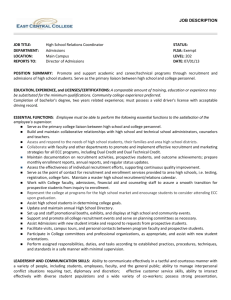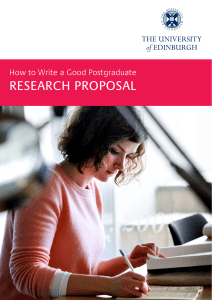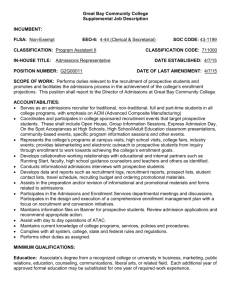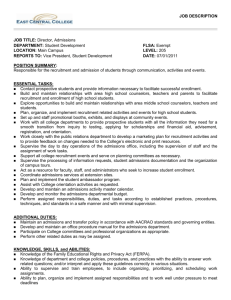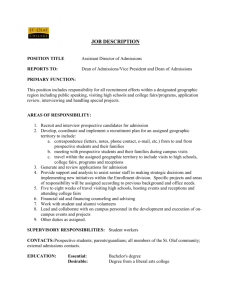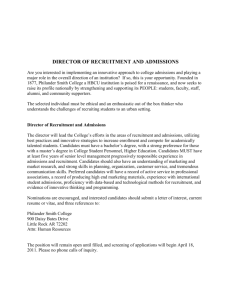How to Write a Good Postgraduate RESEARCH PROPOSAL
advertisement
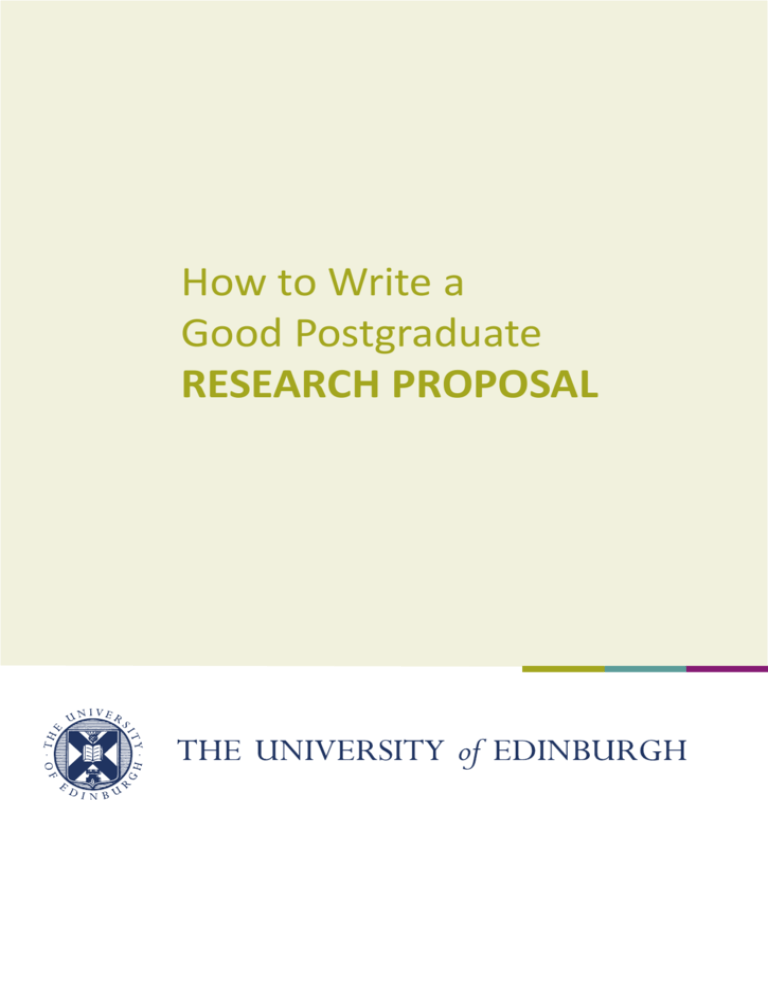
How to Write a Good Postgraduate RESEARCH PROPOSAL Student Recruitment & Admissions www.ed.ac.uk/student-recruitment Introduction This guide provides practical information to those who have been asked to submit a research proposal as part of their application for admissions to a research degree as well as those who are applying to external bodies for postgraduate research funding. A research degree (e.g. Masters by Research, PhD, EdD, DMus) can be one of the best experiences of your life. What you gain along the way will serve you for the rest of life, if only to make you a more confident and knowledgeable person. In addition to making friends, meeting eminent researchers and being part of the research community, it will allow you to develop research skills as well as invaluable transferable skills which you can apply to academic life, your current employment or a variety of professions outside of academia. Student Recruitment & Admissions www.ed.ac.uk/student-recruitment Research Funding In choosing where to do your research degree, a long list of factors will come into play: academic reputation, research experts, location, quality of training and availability of funding. There are several types of funding for postgraduate research: your own funds; external funding bodies such as charities and Trusts; national/ governmental agencies; employers and the private sector and; University scholarships, funded studentships and projects advertised by supervisors. It is a competitive process and will depend on your qualifications, experience and research aspirations. If you already have an idea for your research project or if you are interested in developing your experience in an area of interest within the expertise of a prospective supervisor, you should consider contacting prospective supervisors early on to discuss the possibility of doing a research project under their supervision. How to identify funding sources It takes time to investigate potential funding avenues and to prepare postgraduate research applications, so allow plenty of time. It is not unreasonable to start investigating approximately one year before your proposed start date. The University of Edinburgh’s Scholarships office (www.scholarships.ed.ac.uk) offers a search facility for prospective and existing students. Also remember to check websites of individual departments as they may have additional funding resources and it is where you will find details of research projects. There is also funding available from external funding bodies, including Trusts & charities, research foundations, Government agencies, private sector or your home Government. Search facilities include www.researchresearch.com (available only on campus) and search engines can also be a good idea if you are searching for organisations which fund research in your area of interest. If you are responding to an advertisement for a defined project, it does not mean that you should not pay attention to the first contact you make with the principal researcher on the project. Be sure to highlight how the project fits with your research aspirations and why the chosen academic unit will help you fulfil them. Writing your proposal Whether you’re limited to one page (as part of a University application form or an enquiry form) or asked to produce something more substantial for an external funder, the rules about producing a good research proposal are the same. If you want to stand out from the crowd and have the best chances of being selected, your proposal has to stand out. This guide highlights the “Golden Rules” and provides tips on how to write a good research application. Prospective research students may find it of use when asked to provide a research statement as part of their University application or an informal enquiry form. University Applications Securing funding does not always guarantee a postgraduate research student place at the University. Whether you are applying to conduct your own research or to undertake an advertised project, remember that you will need to apply for a place at the University of your choice before or at the same time as your application for funding. A postgraduate University application is most likely to include a research proposal and/or a personal statement, even if you are applying for a funded project defined by the prospective supervisor. Student Recruitment & Admissions www.ed.ac.uk/student-recruitment Golden Rules for Postgraduate Research Proposals Contents: • • • • • Be clear, objective, succinct and realistic in your objectives Ask yourself why should anyone fund this research and/or why you are the best person for this project Ask yourself why this research is important and/or timely State and justify your objectives clearly (“because it is interesting” is not enough!) Make sure you answer the questions: how will the research benefit the wider society or contribute to the research community? Style: • • • • • If space allows, provide a “punchy” project title Structure your text – if allowed use section headings Present the information in short paragraphs rather than a solid block of text Write short sentences If allowed, provide images/charts/diagrams which may help break up the text The Process: • • • • • • Identify prospective supervisors and discuss your idea with them. Avoid blanket general e-mails to several prospective supervisors! Allow plenty of time – a rushed proposal will show. Get feedback from your prospective supervisor. Be prepared to take their comments on board. If applying to an external funding agency, remember that the reviewer may not be an expert in your field of research Stick to the guidelines and remember the deadline Student Recruitment & Admissions www.ed.ac.uk/student-recruitment Contents and Style of your Research Proposal 1) What to put in your proposal? Application processes are different for each University so make sure to follow the guidelines (For University of Edinburgh applications, guidelines are provided at the start of the online application for admissions). However, if you are not given any guidelines on how to divide your research proposal, you could adopt the structure below. This is also relevant if you are applying for external funding or trying to get your employer to sponsor you to undertake a research degree. Example of structure for a research proposal: • Title and abstract • Background information/brief summary of existing literature • The hypothesis and the objectives • Methodology • How will the research be communicated to the wider community • The supervisory provision as well as specialist and transferable skills training • Ethical considerations • Summary and conclusions 2) Writing the proposal When drafting the proposal, bear in mind that individuals reviewing your application will often have to read a large number of proposals/applications. So, well-presented and clearly written proposals are more likely to stick in the reviewer’s mind. Avoid long and convoluted titles. You will get an opportunity to give more detail in your introduction. Plagiarism Make sure that you acknowledge the authors of ALL publications you use to write your proposal. Failure to do so will be considered as plagiarism. Do not copy word for word what an author has said. You may think that the original author has presented the information with the best possible words in the best format. However, it is best to analyse it and re-write it in your own words. If you absolutely have to quote an author ad verbatim, then make sure that you use quotation marks and italics to indicate it. There are stylistic “golden rules” which contribute to a good proposal: • Be clear, objective and straight to the point (No waffle!) • Justify your objectives: “because it is interesting” is not enough! • Provide a structure and use headings • Avoid long solid blocks of text and use smaller paragraphs • Write short sentences • If allowed and if helpful, insert images/charts/diagrams to help break up text. • Stick to guidelines and the deadline! 2a) Abstract An abstract is a brief summary written in the same style as the rest of your application. It will provide your reader with the main points and conclusion of your proposal. Student Recruitment & Admissions www.ed.ac.uk/student-recruitment 2b) Introduction A well-written introduction is the most efficient way to hook your reader and set the context of your proposed research. Get your reader’s attention early on and do no waste space with obvious and general statements. The introduction is your opportunity to demonstrate that your research has not been done before and that the proposed project will really add something new to the existing body of literature. Your proposal does not have to be worthy of a Nobel prize but it has to be based on sound hypotheses and reasoning. You will have to provide background information in the form of a literature review which helps you set the context for your research to help the reader understanding the questions and objectives. You will also be expected to show that you have a good knowledge of the body of literature, the wider context in which your research belongs and that you have awareness of methodologies, theories and conflicting evidence in your chosen field. Research proposals have a limit on words or pages so you won’t be able to analyse the whole existing body of literature. Choose key research papers or public documents and explain clearly how your research will either fill a gap, complete or follow on from previous research even if it is a relatively new field or if you are applying a known methodology to a different field. Journal articles, books, PhD theses, public policies, government and learned society reports are better than non-peer-reviewed information you may find on the internet. Further practical information on how to conduct a literature review using bibliographic resources can be found on the web: www.ucs.ed.ac.uk/usd/student/courses/library/LRhandout07.pdf www.lib.ed.ac.uk/howto/searchstrat.html Suggested format for an introduction: • Introduce the area of research • Review key publications • Identify any gap in the knowledge or questions which have to be answered • Your hypotheses • Your aims and objectives, including a brief description of the methodology • How is your research beneficial and to whom Although you will develop your ideas further in the main body of the text, your introduction may also include a short summary of your aims and objectives, your methodology and the expected outcomes/benefits of your research as well as who it will benefit and who will be able to use it. 2c) Main body of text Honesty is one of the most important aspects in proposal development so avoid making overambitious claims about the intended research, since what is proposed must be realistically achievable. When drafting the proposal, it is worth asking yourself the following questions and trying to answer them in the text: • Why should anyone spend public, charity or corporate funds on my research and my research training? • Who is my research going to benefit (the stakeholders) or being of use to (the end users)? Stakeholders and end-users include, for example, the research community, a professional body or groups of researchers, a particular group of people such as children, older people or doctors, the government, the industry, health services, social workers…... Try and be specific: stating that your research will benefit the world is perhaps a bit too vague! • Is there evidence, for example in the literature, that my research will fill a gap in knowledge or a market demand? How will it build on the existing body of evidence? • Is my research timely, innovative and/or responding to a new trend? • How will my research proposal address my training needs as well as, if applicable, the needs of my current employer? Student Recruitment & Admissions www.ed.ac.uk/student-recruitment Also have a thorough think about expected outputs to be achieved by the research such as a new database, fundamental knowledge of a new or existing field, publications, attendance at conferences, contribution to a new policy, development of a new technology or service….. It is also very useful to describe the milestones of your research projects (a time plan for every 6 months, for Year 1, 2, 3 or a Gantt chart). This will demonstrate to the reviewer or prospective supervisor that you have really thought of how you are intending on conducting your research. But be realistic! 2d) Methodology – how will you achieve the research aims? It is important to present the proposed research methodology (e.g. techniques, sample size, target populations, species choice, equipment and data analysis) and explain why is the most appropriate to effectively answer the research question. If space allows, it may be a good idea to justify the methodology by explaining what alternatives have been considered and why these have been disregarded. You could also point out how your project fits with the research environment of your prospective place of research and why your chosen university is the best place to conduct your research, in particular if you have access to unique expertise, pieces of equipment or data. 2e) About You The quality of your ideas combined with your ability to carry out the project successfully within your chosen Department/ School/Institute will be a useful addition to your research proposal. You may wish to provide a small section/paragraph to present how your research interests, previous achievements, relevant professional experience and qualifications will support the completion of youe research project. Remember to highlight any project management, data analysis and critical thinking experience you may have gained previously. You could also highlight how a further period of research training will help you achieve your personal and professional development. Avoid overly personal or vague statements but do try to point out: • the most important achievements of your (academic) career: degrees you have obtained, IT skills, societies you were part of, work experience, successful projects you have been involved and, • your best characteristics, eg. motivation, enthusiasm, an inquiring mind, ability to carry out analytical work, a keen approach to research or ability to work independently. 2f) Dissemination If space allows, indicate how you will be communicating with colleagues and your supervisors as well as with the wider community and, if applicable the funding body supporting your research. Examples of dissemination activities are: • Internal seminars • Regular reporting to stakeholders (eg. health service, industrial partner, Government • Publications (eg. journal articles, reviews, book chapters) • Conference presentations • Exhibitions • Outreach (eg. Research Communication in Action) and Public engagement events (eg. Café Scientifique, Biotechnology YES, Edinburgh Science Festival) 2g) Summaries and Conclusions Well-written summaries and conclusions at the end of the proposal and/or at the end of each section can help a reviewer identify the important information. Do not waffle and make sure these are concise, clear and informative – some reviewers will start by reading the conclusions. Reviewers tend to have a large number of applications to review and/or to be very busy people. As a result, each proposal will only receive a short time. Your proposal has to stand out! Student Recruitment & Admissions www.ed.ac.uk/student-recruitment The Process of Applying to External Funding Providers 1) Rules, Guidelines, Eligibility and Deadlines A surprisingly large percentage of proposals are rejected simply because they do not follow the rules and guidelines specified by the funding body. Deadlines are nearly always firm (unless called “rolling”) and it is highly unlikely that they would be amended for anyone. Follow the rules, guidelines and eligibility criteria to the letter! The funder has produced them for a reason and failure to follow these will almost guarantee the rejection of your proposal. 2) Screening process The most popular funding bodies will have a very strict screening process which will be carried out before the reviewer gets to see the proposals. Any application which does not comply with rules and regulations, including editorial ones such as font size or number of pages will not be accepted. The number of proposals will almost always exceed the number of awards available by several folds so do not provide reasons for your application to be rejected on format. 3) The application process Bear in mind that some funders have closing dates early in the year so it is a good idea to start the studentship application as soon as possible (about a year before your proposed start date). External funders will often ask you to have, at least, a conditional offer of admission at the proposed university or to have an endorsement from the university you are planning to go to. Some funding will only be tenable at the university stated in the application so make sure you read all the guidelines. 3a) Discuss and develop your idea You may start the funding application process by identifying a suitable supervisor and discussing the idea for your research project with him/her. Your prospective supervisor will be an integral part of your application and should be able to offer further support with your application. You can look for potential supervisors by visiting the prospective University website, review the research expertise which fits your chosen field best and then search for researchers who could be potential supervisors. It is a good idea to have a good general overview of your supervisor’s research expertise as a courtesy to them when you contact them for the first time. This will also allow you to ensure that they are the best person to advise you on your proposal. More information is provided in the previous section on how to write a good research proposal/postgraduate research application. You may wish to send an abstract of your research idea or a draft research proposal to prospective supervisors prior to submitting your application, meeting them or talking to them over the phone or by e-mail. Make sure your draft is of good quality and it is best not to send the same proposal to all potential supervisors. Be prepared to listen to their advice and to answer questions. Critical appraisal is a skill that academic staff have developed over many years so don’t be offended if you get a lot of comments and take advantage of the expertise and experience of your prospective supervisor. Finally and very importantly, do not assume that your prospective supervisor will or should do all the hard work for you. It is YOUR proposal! Fellow students, friends and colleagues can also act as lay readers/ proofreaders and give a different perspective on your proposal in particular on the aims of your research. Student Recruitment & Admissions www.ed.ac.uk/student-recruitment 3b) Find a potential research studentship funder If you are seeking external funding for your own project, the next step is to find the most appropriate funding body and funding stream for your particular research project. Your prospective supervisor and previous undergraduate/Masters study advisors will be excellent sources of knowledge in this area. Other members of staff in university’s scholarships offices, careers services, research support offices or student recruitment and admissions (if they have staff specialising in postgraduate studies) may be able to help you. Before you start developing the research proposal, it is worth researching your chosen funding body (whether it is a university or an external funding agency) and the web is a good place to start. Once an opportunity has been identified, you should ensure that you have checked: • • • • • • that your research idea is in a research area supported by the prospective funder; that you are eligible to apply (e.g. nationality, affiliation, qualifications); that you have allowed sufficient time for drafting the research proposal; that you understand fully the funder’s selection process; that you have allowed sufficient time to complete the proposal for the closing date and; how the application should be submitted to the funder. Some funders (eg. AHRC and ESRC) require that you register on their system and may require approval from your prospective University. 3c) Before you start writing All funders (government funded research councils, universities, research charities, or private companies) have objectives to fulfil set by the people and organisations that they answer to, including stakeholders and financial supporters. When they invest in research, they are looking for that investment to help them achieve those objectives. For private sector employers, it may be to improve their business processes, increase their R&D potential or to train employees. For research charities, it may be to find ways to help particular groups of people such as those in unemployment or those affected by a medical condition. All funders, universities and prospective supervisors want good applications. However, they will have different ways of reviewing your application and may have strict criteria against which to assess your proposal. Try and be objective. For example, if your research proposal involves a 10-year geological survey, it is unlikely that the funder will want to fund it as a PhD studentship which is set to last for a defined and shorter period of time. Similarly, if your proposal contains too few or too many research activities for the period of proposed research training, they will be reluctant to fund it. The former will not be considered good value for money and the latter will be perceived as having a risk of failure against the objectives planned at the beginning of the project. Make sure you consider how best to present the ideas/objectives of the research project and their value clearly as there is stiff competition for postgraduate research awards. A proposal should not just be “good enough” but one of the best. 3d) Lay summary In addition to an abstract and an introduction, you may be asked to produce a lay summary, the impact of which is not to be under-estimated. While funders may use expert panels to assess research proposal, the final decision may rest with individuals (for example: Trustees from a charity) who will not necessarily have the expertise in your proposed field of research. Make sure you “grab” the reader attention by presenting a clear and succinct summary. As an indication, some Research Councils advise that the lay summary be written in a style which should allow reasonable understanding by an interested 14-year old. Student Recruitment & Admissions www.ed.ac.uk/student-recruitment 3e) Training and supervision The training and supervision of research students is an important consideration. Prospective PGR student applicants will be expected to bear great importance to their gaining of specialist and transferable skills so, if the funder requires it, indicate what provisions are in place at your proposed University. The University runs one of the best and most proactive transferable skills programmes: www.transkills.ed.ac.uk The University’s website will also be provide information regarding the facilities and structure for your specialist training e.g. skills in a particular technique, access to archives, a seminar programme (to which you may be asked to contribute), a mentoring scheme (if in place) or access to a Graduate School. 3f) Dissemination Funders want others to be helped and inspired by the research that they support, therefore proposals which highlight what the expected benefits of the research are and how the research findings will be communicated to the wider community, have a greater chance of success. Please note that some funders have strict rules about reporting but it does no harm to indicate that you will comply with that. Other funders such the private sector may sometimes request an embargo period for your research to be published so you must check, with your supervisor, what the terms and conditions are. Examples of dissemination activities are provided in section 2.2.7. 3g) Ethical considerations Funding bodies have strict rules and expectations of the standards with which the research they fund should be carried out. Project proposals must therefore include potential ethical issues raised by the conduct of the research and funders will want to see how these will be addressed should they occur. This is particularly important if your research project is deemed “high risk” i.e.: if it involves animals, sensitive materials or vulnerable groups such as children or adults with disabilities. You may also be asked to indicate what the ethical approval system is in your prospective School. Your supervisor will be able to provide you with this information. Student Recruitment & Admissions www.ed.ac.uk/student-recruitment Other resources *The Postgraduate Companion (2008). Chapters 4-7; Hall G. and Longman J. Eds, Sage Publications London, UK. *The PhD Application Handbook (2006). Bentley PJ. Eds, Open University Press, Maidenhead, UK. *Vitae (formerly UKGRAD): http://www.vitae.ac.uk/ *”What do PhDs do”: Link to WDPD; Link to “What motivates PhD students”; Link to “Getting the most out of your PhD” Student Recruitment & Admissions www.ed.ac.uk/student-recruitment Produced by Dr Nathalie Mather-L’Huillier, PGR Recruitment & Admissions Manager, Student Recruitment & Admissions, The University of Edinburgh postgraduate-enquiries@ed.ac.uk This leaflet is available to download in PDF format on our website: www.ed.ac.uk/studying/postgraduate The University of Edinburgh is a charitable body, registered in Scotland, with registration number SC005336. ©The University of Edinburgh, 2010 Student Recruitment & Admissions www.ed.ac.uk/student-recruitment
